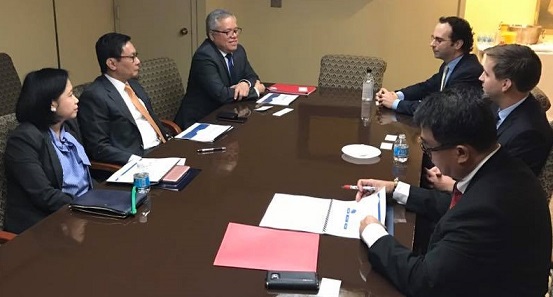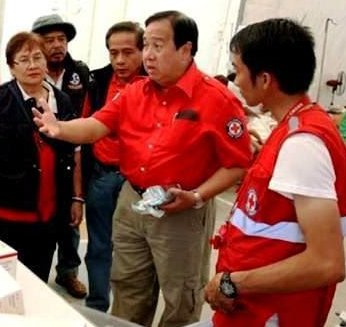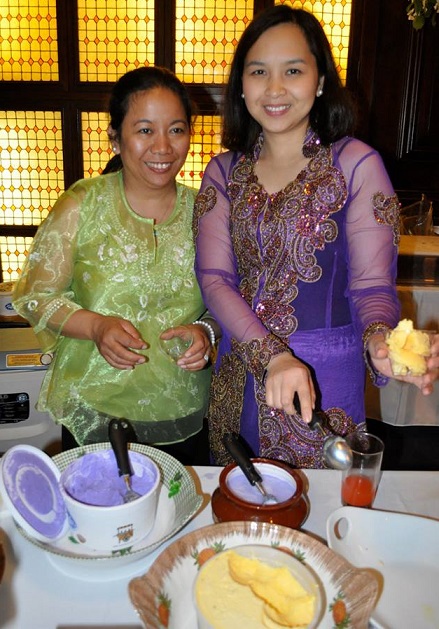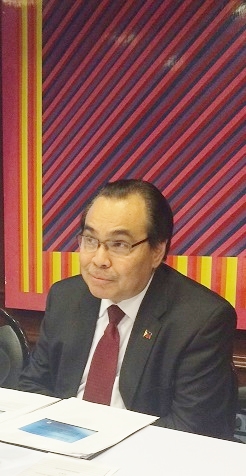Trade secretary says PHL economy is looking good, ‘DuterteNomics’ paves the way

Trade and Industry Secretary Ramon Lopez at a town hall with the Filipino American community. Photos: Philippine Consulate/New York
Trade and Industry Secretary Ramon Lopez touted ‘DuterteNomics’ in a swing through New York saying it offers “real solutions to poverty” that still plagues millions of Filipinos.
DuterteNomics is the government’s way of making it easy for investors to do business in the Philippines. “It will reduce inequality, increase competitiveness of industries, create decent jobs, and empower the nation,” he said.
Lopez said trade is being propped up by semiconductors and electronics, the bright spots in the country’s manufacturing sector. Texas Instruments, based in Dallas, and Toshiba Information Equipment, Inc. are among the companies that are heavily invested in the Philippines.
“They are our biggest exports,” Lopez told American investors and members of the Filipino American community at an August 31 town hall held at the Philippine Consulate’s Kalayaan Hall.
The Department of Trade and Industry website says there are 424 electronics firms with facilities scattered across ‘special economic zones’ in Baguio, Calabarzon, Cebu, Clark, and Metro Manila. “About 73 percent of the total number of Philippine electronics companies provide SMS (Short Message Services) and 27 percent provide EMS (Enhanced Messaging Service) capabilities,” it says.
The electronics industry, with an export value of $23.9 billion in 2013, rose to $28.8 billion in 2016. The top earners are semiconductor components, electronic data processing, and automotive electronics.
The manufacture of automotive parts is particularly strong, Lopez said. Toyota and Mitsubishi are among the automobile companies that have assembly plants in the Philippines.
Aerospace manufacturing is also seeing robust growth, producing aircraft, guided missiles, space vehicles, aircraft engines, and parts.

Meeting with foreign investors. With Lopez are Consul General Tess Dizon-De Vega and Nicanor Bautista, Special Trade Representative to New York (second from left).
“Parts, such as seats, interiors of aircraft cabins, are being made in the Philippines for big companies like Boeing and Airbus,” said Lopez. Boeing, based in Chicago, is the biggest aircraft manufacturer in the world; Airbus is its European rival.
Last year, DTI reported the aerospace industry posted a steep increase in revenue, from $5.9 million in 2008 to $226 million in 2014. The industry is projecting its share of Gross Domestic Product will rise from .15 percent in 2013 to .57 percent in 2022, according to the department website. The industry’s growth is powered by the country’s young and trainable labor force, the growth of aviation schools, and the modernization of domestic airlines.
In the open forum, Lopez was asked about Artificial Intelligence and whether it will replace the labor force, especially in manufacturing. AI is an enhanced form of robotics and computerization that will hit factories and economies across the globe as they replace large amounts of clerical and manual labor.
“AI can be prevented by retraining and retooling the work force,” said Lopez.
He cited as example the banking industry where the ATM machines did not entirely replace the bank employees. He said AI can handle more complicated forms of jobs, and support manual processes. “AI can work for you and not replace you.”
Consul General Tess Dizon-De Vega said the Philippines’ 6.5 percent GDP growth in the second quarter – from 6.4 percent in the first quarter — shows “dynamism” across all sectors of the economy, including manufacturing, industrial and agricultural.
Two-way trade between the Philippines and the U.S. has grown by more than 25 percent, and the U.S. remains an important trading partner.
“We have strong people to people relations, we understand each other,” she said.
© 2017 The FilAm











